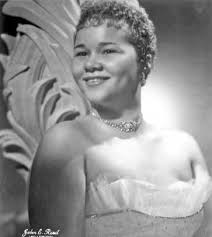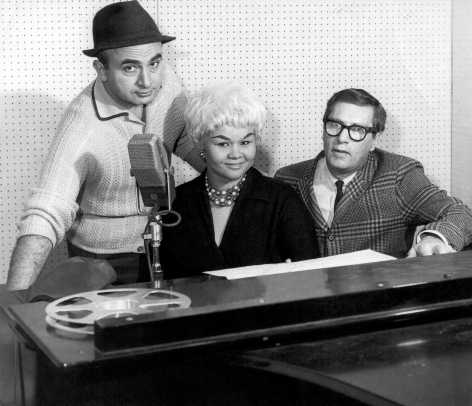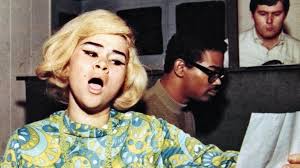Carl Craig Music Producer/DJ
Carl Craig is a music producer and DJ who was a trail blazer within the “Detroit Techno” realm. Carl Craig is considered ” one of

I conducted this research by finding scholarly articles that included both information on Etta James intesense childhood as well as her numerous accomplishments. Her music has broken down barriers for many Black Artists that are popular today. I researched her as an influential artist that is labeled to be one of the pioneers of changing the face of Soul as well as Rock and Roll. From this research, i was able to find interviews, articles, autobiography and archival data that helped to explain why Etta James is an reknown Mystery Woman.





Very few R&B artists managed to recieve the kind of consistent reclaim Etta James recieved throughout a career over the time span of six decades. Etta James was created in a era where music was constantly changing. Jazz and Blues became a wildfire across the United States. Many individuals saw music as a drug. Something that left people wanting more and would do anything to get; a motto many Artists during that time lived by. she recorded a number of enduring hits, including “At Last,” “Tell Mama,” “I’d Rather Go Blind,” and “All I Could Do Was Cry.” At the same time, despite possessing one of the most powerful voices in music, James only belatedly gained the attention of the mainstream audience, appearing rarely on the pop charts despite scoring 30 R&B hits, and she lived a rough-and-tumble life that could have inspired a dozen soap operas, battling drug addiction and bad relationships while outrunning a variety of health and legal problems.
On January 25, 1938 Jamesetta Hawkins more widely known as Etta James was born in South Central LA. Unfortunately, mystery was present in Etta James life since birth. Both her father and mother were not present. The birth of Etta James was covered in secrets, deceit, and mystery. James explains that the woman she knew to be her mother was a person who was seen to be unstable and the “Mystery Woman.” This mystery woman was Dorothy Hawkins. Hawkins was a very vibrant young woman who was seen to be the show stopper wherever she went. She was very voluptuous and all the men flocked around her when she was present. Etta was introduced to Jazz at a very young age because of her mother’s love for jazz music. Artists such as Charlie Parker, Sarah Vaughan and Lester Young were just to name a few that Hawkins loved. James mother explained to her that her father could have been serval men, but thanks to Etta’s aunt Cozetta, the truth about her conception would be revealed. Hawkins moved from Nebraska to California to live with Cozetta when their mother died. She was ten years older than Hawkins and worked as a madam. Her aunt explained that Dorothy was attending the local high school when she became pregnant at the age of 14. The authorities charged a mechanic by the name of Al Anderson with statutory rape for Dorothy Hawkins but was still listed as the father on the birth certificate. Hawkins was placed in a reform school and later went under non-conception surgery. Etta’s Aunt Cozetta and her husband James would be her legal guardians taking her to Sacramento. After months of traveling throughout California, Etta and her parents traveled back too South Central, where Etta was reunited with Hawkins after she was recently released from reformed school.
Etta James was soon given over to an elderly couple Lula and Jesse Rogers, who lived above her and Hawkins in the apartment complex they stayed in. As time went on Etta still had questions about the man who could be her father. Asking Hawkins for the name of her father was a painful process James explains. She would often be brushed off or her mother would quickly switch the subjects when the topic was apparent. It was until one night, James was called over into the living room while Hawkins was watching television and was given the information that her father was the man on the screen. This man was “Minnesota Fats,” a man who was known to be a famous pool player.
At the age of five years old, Etta James became a signing phenomenon. St. Paul Baptist Church became her platform to show the world her amazing and unique talent. The news broke out that there was a little girl who had an old woman’s voice that could rock a house down. Celebrities such as Robert Mitchum, Lana Turner, and Orson Welles would visit the church just to hear James. As the church began to become more popular, James would be the main attraction and started to become the headliner for things such as concerts and community fundraisers. James father Jesse began to visit the church but greatly disliked the manner in which Etta was being treated. Her father believed that with a voice like hers she needed to be the only one to sing the solos. He also explained that he had a dislike for the pastor of the church, Reverend Branham. One day the two men got into a huge disagreement and just like that Etta James was no longer a member of the St. Paul Baptist Church. After that day, James never sang in front of a church congregation.
Now as a young adult Etta James began to experiment in many ways, being in a gang was the first. James began to be kicked out of numerous schools for fighting and was placed in juvenile detention for a short period of time. During this time music was still happening hot and heavy. James and a two of her friends created the music group “Creolettes.” After a while the group were becoming a pretty popular girl group around town. They began to win amateur shows and attracting a good crowd. They began to practice more bringing in new chorography, putting on at least 20-minute shows, and gaining the confidence they always wanted. On night, the Creolettes met Johnny Otis and were able to sing for him. Otis was amazed by their talents and asked them to come to LA when him to performed on one of his sets. At the age of fourteen Etta’s childhood had ended and her professional career had begun. Otis quickly changed the group’s name from the Creolettes to the Peaches. The Peaches traveled with Otis and his traveling show, but after a while Etta knew she wanted more than to just be in the shadows of Johnny Otis. With help from a new Agent Carl Peterson, Etta and the Peaches were able to get away from Otis and travel on the road. After being on the road for a while, James returned back to LA where she was booked to perform with a man by the name of Big Jim Wynn. He was a saxist who played with Johnny Otis but wanted to adventure on his own. Big Jim soon became her legal guardian and boosted her salary as well as bringing on another musical genius by the name of Johnny “Guitar” Watson. Couple of years later, James was booked with a new Agent by the name of Billy Shaw. He was able to land James gigs into black theatres—The Apollo in Harlem, the Royal in Baltimore, and the Howard in D.C.
James moved to Chicago where she was introduced to a man by the name of Leonard Chess who would be the man to take her career to what it is known to be today. Chicago is where all the baddest blues singers from the Mississippi Delta migrated to. Etta was able to buy out her contract with Modern for three thousand dollars, and land a recording deal with Chess Records for five thousand dollars. Chess was looking for more women to be a part of the recording company, according to him he had enough male artists (Bo Biddley, Chuck Berry, and Little Walter). Etta started out as just a writer for Chess Records until Leonard thought it was appropriate to start promoting her. It was not until music started to shift and the word “cross over” became a prominent word and concept throughout the music world. “All I Could Do Was Cry” was the first hit James recorded as an artist for Chess Records. All I Could Do is Cry was a song about a woman who was watching the very man she loved marrying another woman. Unfortunately, Etta did not see any monetary rewards from the song right away and still struggled to find her notch at Chess Records. The following song that landed Etta James on the map was a song titled “At Last.” To this day “At Last” is one of the most requested songs; whether it pertains to a wedding, birthday party or a regular social gathering. Etta James had finally “crossed over.” According to Leonard Chess James was the first soul artist for their label to take them out of the Old delta blue, out of rock and roll into modern era. Soul was the new direction at the time.
Etta James life took a turn when the love of heroin became stronger. More than alcohol or marijuana, heroin gave her the type of feeling she never experienced before. She once said “Heroin hit me hard. I loved it. Heroin became my drug of choice. It took me where I wanted to go, far away, out of it. All pain, thought and confusion melted under its lazy hazy spell. I grooved on the zapped-out sensation. I liked the nod, I liked the hot rush of he dope speeding through my system. If I felt vulnerable and anxious when I was straight, I felt unapproachable and mellow when I was high.” James even explains that the drugs kept her weight off, something she had been battling with since she was in high school. Soon after James had met a pimp who remains nameless in which she fell in love with. The pimp was her first serious boyfriend and met in New York in 1962. He was an ex-heroin junkie. Women loved him, and had a reputation for violence. It was rumored that he killed his last girlfriend, and at the age of the fourteen he killed a man. These stories according to Etta “excited her.” After a horrible altercation between her and the pimp, Etta landed into the local hospital and was able to press charges. Life fast forward and Etta James recorded her third big hit “I’d Rather Go Blind.” The song crossed and top the pop charts being a hit for weeks.
Soon James found out that she was pregnant but was faced with the reality that she was caring a child by a man who did not want her. On March 23rd 1968 her son Donto was born. By thirty years old, Etta James had been put in the same category of Aretha Franklin and Otis. This is time where Soul had grown and became very popular. She was nominated for a Grammy four times but did not win.
Her records continued to chart in the R&B Top 40 in the early 1970s, with singles such as “Losers Weepers” (1970) and “I Found a Love” (1972). Though James continued to record for Chess, she was devastated by the death of Leonard Chess in 1969. James ventured into rock and funk with the release of her self-titled album in 1973. The album, known for its mixture of musical styles, was nominated for a Grammy. The album did not produce any major hits; neither did the follow-up, Come a Little Closer (1974). James continued to record for Chess, now owned by All Platinum Records releasing one more album in 1976, Etta Is Betta Than Evvah! Her 1978 album Deep in the Night, produced by Jerry Wexler for Warner Bros., incorporated more rock-based music in her resume.
James has received 30 awards and recognitions from eight different organizations, including the Rock and Roll Hall of Fame, and six Grammy Awards. Her first Grammy was in 1995, when she was awarded Best Jazz Vocal Performance for the album Mystery Lady, which consisted of covers of Billie Holiday songs. Two other albums have also won awards, Let’s Roll (Best Contemporary Blues Album) in 2003, and Blues to the Bone (Best Traditional Blues Album) in 2004. Two of her early songs have been given Grammy Hall of Fame Awards for “qualitative or historical significance”: “At Last”, in 1999, and “The Wallflower (Dance with Me, Henry)” in 2008. In 2003, she was given the Grammy Lifetime Achievement Award.
In 2008, James was portrayed by Beyoncé Knowles in the film Cadillac Records, a fictional account of Chess Records, on how label founder and producer Leonard Chess helped the careers of James and others.
James was hospitalized in January 2010 to treat an infection caused by MRSA, a bacterium resistant to most antibiotics. During her hospitalization, her son Donto revealed that she had received a diagnosis of Alzheimer’s disease in 2008. She was diagnosed with leukemia in early 2011. The illness became terminal, and she died on January 20, 2012, just five days before her 74th birthday, at Parkview Hospital in Riverside, California.
Carl Craig is a music producer and DJ who was a trail blazer within the “Detroit Techno” realm. Carl Craig is considered ” one of
“Studio 54” was first opened in 1927 and was named the “Gallo Opera House”, after its owner Fortune Gallo. The Gallo had many failed
Hip-Hop has been a major influence within the black culture for decades. It serves as an outlet for an artist to express their opinions, desires
For centuries, those who are of African-decent have been in a constant uphill battle against society. Since slavery there has been the results of colorism,

Janet Damita Jo Jackson was born on May 16th, 1966. She is a singer, dancer and actress. She is most known for her sonically innovative, socially

Michael Eugene Archer formerly known as D’Angelo, is a fourteen Grammy Nominated R&B Artist, winning Best R&B album, Best Male R&B Vocal Performance in
James, Etta, and David Ritz. 1995. Rage to Survive : The Etta James Story. 1St ed. New York: Villard Books.

Login to your account